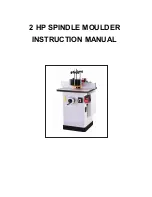
40
The thicker the blade, the stiffer the blade and the straighter the cut. The
thicker the band, the greater the tendency for the blade to break.
The size of the teeth. This is usually quoted in teeth per inch (TPI). The larger the
tooth, the faster the cut because the tooth has a large gullet and has a greater
capacity to transport large amounts of sawdust through the job. The larger the tooth,
the coarser the cut and the poorer the surface finish of the cut. The smaller the
tooth, the slower the cut as the tooth has a small gullet and cannot transport large
amounts of sawdust through the job. The smaller the tooth, the finer the cut and the
better the surface finish of the cut
When choosing the blade with the proper pitch, one factor you should consider is
the hardness of the material that is being cut: the harder the material, the finer the
pitch that is required. For example, exotic hardwoods such as ebony and rosewood
require blades with a finer pitch than American hardwoods such as oak or maple.
Soft wood such as pine will quickly clog the blade, decreasing its ability to cut.
Having a variety of tooth configurations in the same width will most likely give you an
acceptable choice for a particular job.
There are certain things that indicate if a
blade has a proper pitch, too fine a pitch or too coarse a pitch. Some are listed
below:
Blades cut quickly
.
A minimum amount of heat is created when the blade cuts
.
Minimum feeding pressure is required
.
Minimum horsepower is required
.
The blade makes quality cuts for a long period
.
The blade cuts slowly.
There is excessive heat, which causes premature breakage or rapid dulling.
Unnecessarily high feeding pressure is required.
Unnecessarily high horsepower is required
The blade wears excessively.
The blade has a short cutting life.
The teeth wear excessively.
The bandsaw vibrates.
Thickness
Pitch
Material hardness
Proper pitch
Pitch is too fine
Pitch is too coarse
Summary of Contents for 14-Twelve Bandsaw
Page 53: ...53 Electrical Drawing...
Page 54: ...54 Industrial Work Light Optional Exploded View Drawings and Parts List...
Page 55: ...55 Lower Wheel And Motor Assembly...
Page 56: ...56 Stand Assembly...
Page 57: ...57 Table and Fence Assembly...
Page 58: ...58 Upper and Lower Blade Guides Assembly...
Page 59: ...59 Upper Wheel Assembly...
Page 60: ...60 Wheel System Optional...
















































